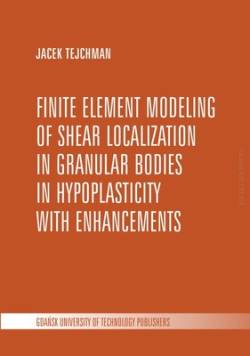Finite element modeling of shear localization in granular bodies in hypoplasticity with enhancements
- Dodaj recenzję:
- Kod: 2870
- Producent: Wydawnictwo Politechniki Gdańskiej
- Autor: Jacek Tejchman
-
Finite element modeling of shear localization in granular bodies in hypoplasticity with enhancements
rok wydania: 2005
ISBN: 83-7348-114-1
Opis
The intention of this book is to present the capability of a hypoplastic constitutive law enriched by a characteristic length to capture shear localization in cohesionless granular bodies on the basis of finite element analyses for plane strain and an axisymmetric case during monotonous deformation paths. A hypoplastic constitutive law (which was formulated at the Karlsruhe University in Germany) is an alternative to elasto-plastic formulations for continuum modelling of granular materials. It describes the evolution of effective stress components with the evolution of strain components by a differential equation including isotropic linear and nonlinear tensorial functions. In contrast to elasto-plastic models, the decomposition of deformation components into elastic and plastic parts, yield surface, plastic potential, flow rule and hardening rule are not needed. The constitutive law takes into account the influence of density, pressure and direction of deformation. To capture a characteristic length, a hypoplastic constitutive law was enhanced by polar, non-local and second-gradient terms. The potential of a hypoplastic constitutive law with enhancements to describe shear localization in granular bodies was demonstrated with own finite element solutions of various rate boundary value problems. The finite element calculations with a micro-polar hypoplastic were carried for plane strain compression, simple shearing, biaxial compression, strip foundation, earth pressure, direct and simple shear test, cyclic loading, granular anchors, bedding, silo filling, silo buckling and silo flow. In the case of a non-local and second-gradient hypoplastic approach, the results for plane strain compression were described.
Spis treści
List of symbols
1. Introduction
2. Literature overview
2.1. Experiments
2.2. Theory
3. Hypoplasticity
3.1. Hypoplastic constitutive law for monotonous deformation paths
3.2. Hypoplastic law with elastic range (Niemunis and Herle 1997)
3.3. Hypoplastic law for anisotropic materials (Bauer et al. 2004)
3.4. Hypoplastic law for soils with low friction angles (Herle and Kolymbas 2004)
4. Calibration of material constants
4.1. Critical friction angle 0r
4.2. Granulate hardness hs and exponent n
4.3. Minimum void ratio eM at zero pressure
4.4. Maximum void ratio e,o at zero pressure
4.5. Critical void ratio e^ at zero pressure
4.6. Parameters <= and ft
5. Enhanced continua
5.1. Micro-polar continuum
5.2. Non-local continuum
5.3. Gradient continuum
6. Micro-polar hypoplastic constitutive model
7. Finite element implementation
7.1. Finite element equation of motion (micro-polar continuum)
7.2. Element displacement interpolation matrix
7.3. Strain-displacement matrix
7.4. Stress-strain matrix
8. Finite element results with a micro-polar hypoplastic model
8.1. Plane strain compression test
8.2. Monotonous shearing of an infinite layer
8.3. Cyclic shearing of an infinite layer
8.4. Cyclic compressionextension
8.5. Biaxial compression
8.6. Strip foundation
8.7. Earth pressure
8.8. Direct and simple shear test
8.9. Wall direct shear test
8.10. Silo problems
8.11. Granular anchors
9. Non-local hypoplastic constitutive model
9.1. Finite element data
9.2. Finite element results
10. Gradient hypoplastic constitutive model
10.1. Finite element data
10.2. Finite element results
11. Comparison between micro-polar, non-local and gradient model
11.1.Finite element data
11.2. Finite element results
12. Conclusions
References
rok wydania: 2005
ISBN: 83-7348-114-1
Opis
The intention of this book is to present the capability of a hypoplastic constitutive law enriched by a characteristic length to capture shear localization in cohesionless granular bodies on the basis of finite element analyses for plane strain and an axisymmetric case during monotonous deformation paths. A hypoplastic constitutive law (which was formulated at the Karlsruhe University in Germany) is an alternative to elasto-plastic formulations for continuum modelling of granular materials. It describes the evolution of effective stress components with the evolution of strain components by a differential equation including isotropic linear and nonlinear tensorial functions. In contrast to elasto-plastic models, the decomposition of deformation components into elastic and plastic parts, yield surface, plastic potential, flow rule and hardening rule are not needed. The constitutive law takes into account the influence of density, pressure and direction of deformation. To capture a characteristic length, a hypoplastic constitutive law was enhanced by polar, non-local and second-gradient terms. The potential of a hypoplastic constitutive law with enhancements to describe shear localization in granular bodies was demonstrated with own finite element solutions of various rate boundary value problems. The finite element calculations with a micro-polar hypoplastic were carried for plane strain compression, simple shearing, biaxial compression, strip foundation, earth pressure, direct and simple shear test, cyclic loading, granular anchors, bedding, silo filling, silo buckling and silo flow. In the case of a non-local and second-gradient hypoplastic approach, the results for plane strain compression were described.
Spis treści
List of symbols
1. Introduction
2. Literature overview
2.1. Experiments
2.2. Theory
3. Hypoplasticity
3.1. Hypoplastic constitutive law for monotonous deformation paths
3.2. Hypoplastic law with elastic range (Niemunis and Herle 1997)
3.3. Hypoplastic law for anisotropic materials (Bauer et al. 2004)
3.4. Hypoplastic law for soils with low friction angles (Herle and Kolymbas 2004)
4. Calibration of material constants
4.1. Critical friction angle 0r
4.2. Granulate hardness hs and exponent n
4.3. Minimum void ratio eM at zero pressure
4.4. Maximum void ratio e,o at zero pressure
4.5. Critical void ratio e^ at zero pressure
4.6. Parameters <= and ft
5. Enhanced continua
5.1. Micro-polar continuum
5.2. Non-local continuum
5.3. Gradient continuum
6. Micro-polar hypoplastic constitutive model
7. Finite element implementation
7.1. Finite element equation of motion (micro-polar continuum)
7.2. Element displacement interpolation matrix
7.3. Strain-displacement matrix
7.4. Stress-strain matrix
8. Finite element results with a micro-polar hypoplastic model
8.1. Plane strain compression test
8.2. Monotonous shearing of an infinite layer
8.3. Cyclic shearing of an infinite layer
8.4. Cyclic compressionextension
8.5. Biaxial compression
8.6. Strip foundation
8.7. Earth pressure
8.8. Direct and simple shear test
8.9. Wall direct shear test
8.10. Silo problems
8.11. Granular anchors
9. Non-local hypoplastic constitutive model
9.1. Finite element data
9.2. Finite element results
10. Gradient hypoplastic constitutive model
10.1. Finite element data
10.2. Finite element results
11. Comparison between micro-polar, non-local and gradient model
11.1.Finite element data
11.2. Finite element results
12. Conclusions
References



